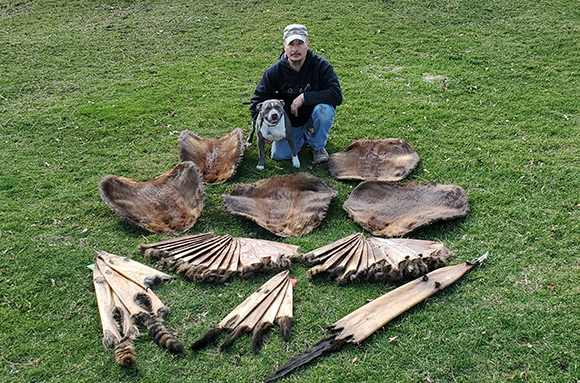 Team Fur News - Feb24
Team Fur News - Feb24
The Last Day
By FUR-FISH-GAME Editor, John D. Taylor
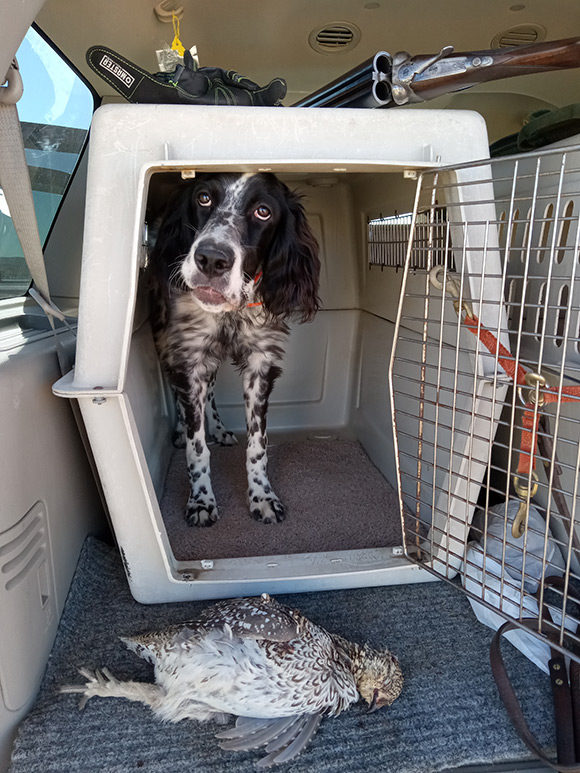
Willa, Taylorís young English setter, and her sharptail.
There are times when I wish I could be like Professor Dumbledore in the Harry Potter series of books and movies. Dumbledore, headmaster at Hogwarts School for Wizards, can point his magic wand at his temple and pull from his brain memories, so he can share them with others. He does this for Harry Potter, dunks a memory into the pen sieve, a pool of water in what looks like a baptismal fount, so Harry can poke his face into the water and see, feel, almost touch the memory, understand the experience.
That’s what I’d like to do for you, only my magic would be much simpler. I just want to transfer the experiences in my head to some vehicle so others can know some of what I’ve experienced outdoors – maybe that dawn pronghorn stalk I made in September, or to know what it’s like to have a strutting Merriam’s gobbler come looking for you on a fine spring day, but especially to watch my dog’s work. Call it the Taylor ESPN Outdoor Network. No charge to get in.
Since I can’t do that, I’ll have to rely on my words to invoke your imagination. Maybe you’ll get a glimpse, a sense of it.
Take, for example, the last day of sharptail season, January 7, here in South Dakota.
I was hunting my two English setters – year-and-a-half-old blue belton Willa, and 11-year-old orange belton Ellen – in a very large expanse of Perkins County Conservation Reserve Program (CRP) ground. This spot, designated a Walk-In Area by Game, Fish and Parks, was shaped somewhat like the prongs of the pitchfork I use to throw hay to my horses. Maybe that’s what drew my attention to it. It was a new-to-me Walk-In, a place to explore.
Actually, I was looking more for pheasant cover, not prairie grouse habitat.
South Dakota’s severe 2022 winter made West River pheasants a rare commodity considering the state’s pheasant mecca reputation. I’d flushed just a few roosters all fall – including that cluster of five long-tailed, green-head banshees Ellen busted, maybe not on purpose, from the edge of a cut cornfield during Halloween.
Native sharptails and prairie chickens evidently survived the winter far better. All the snow busted the drought, creating rich grassland growth with plenty of insect life for chicks, a boon for gallinaceous birds.
We’d been getting into scads of prairie grouse all fall. On the drive up to what I was now calling the Pitchfork Covert, a 100-bird flock of sharptails flushed from a cut wheat field and sailed over my truck traveling on gravel Stoneville Road. I stopped to watch them pump wings a few times and glide over. Half a dozen sharptails landed in the bare cottonwoods in Stoneville, population four souls, five outbuildings, six junked cars and two trailer houses. That scene was repeated with 100 prairie chickens west of state capital Pierre earlier in the season. The flock flushed 70 yards in front of my pointing setters.
This abundance was exactly what Miss Willa needed to come of age as a sharptail specialist. She’d grown from a puppy hesitant to nuzzle the still warm and kicking sharptail I knocked down during her first season in northeast Wyoming, to an adult-sized setter trying to beat Ellen to any find or retrieve. After Wyoming’s slim bird pickings, I was so thankful for this.
So, when I saw Pitchfork’s prongs were surrounded by harvested corn and cut wheat, I figured more pheasants than sharptails. Was I wrong.
Willa and Ellen first cast through the frozen-over cattail-laden low spots in the Walk-In, on the first prong of Pitchfork, adjacent to the cut corn. I noticed a few pheasant tracks among the many pectinated grouse footprints in the snow. But we moved no pheasants.
Thinking we might have pushed rooster into the grass above the cattails, we continued.
Willa flowed gleefully through the knee-high grass, a streak of movement, black mask and spots contrasting against the snow that absorbed the rest of her. Ellen’s more careful race showed an old pro at work. She flowed through the grass, head popping above the stems. She’d get a scent, stop, look back at me to follow, then work it to the source.
Still no pheasants.
When we’d covered Pitchfork’s first prong up to where the prong joined the fork’s butt, the knee-high grass was bent south and east by prevailing northwesterlies. To keep noses in light breeze that blue sky day, we continued north, the walking harder for me against the grain of the grass.
A mile of the fork’s butt grassland sprawled in swales and little gullies in front of us, connecting all three prongs, east and west. A dozen steps into this, the first sharptail flushed, 75 yards out. It got up lazily, suggesting the bird was roosting, enjoying being safe from predators, warmed by the 40-degree sunshine.
Both setters saw this bird go and got excited by it, their casts arcing harder for that magic scent of Bird - Here!
Looking beyond them, I noticed scads of deer, whitetails and mulies ahead. With deer seasons closed – did they check the hunting handbook? – the deer felt safe from an orange-hatted fella toting a side-by-side shotgun with two dogs in front of him. I’d seen pronghorns follow my orange belton setters many times, perhaps thinking the orange and white critters were their kind. The deer did that, too, but bolted when we got closer.
We’d followed the fork’s butt, working the edge almost to the far fence line. We then swung west to keep the wind. And that’s when another sharptail flushed at 30 yards.
I dropped it. The dogs found the bird in the high grass, Kent’s Upland Fasteel No. 6s having performed perfectly.
I praised the setters, picked up the bird, offered thanks and stroked its mottled brown, black and white plumage back into something resembling living place.
Sharptail beauty, bird-in-hand, always amazes me. In such moments, part of me wants to release it to fly away, like a fly-caught trout. But the finality of hunting lends what should be a reverence to the endeavor, its true magic. And Nancy and I would enjoy this sharptail on the table, too.
After pocketing the grouse in my vest’s game pouch and giving thirsty dogs a drink, we moved on.
I’d like to report perfect dog work, a point and honor on the next sharptail. But I didn’t have that. The dogs were working well ahead and must have missed scenting the next bird. It flushed 20 yards out, sailing away right to left. I missed with the first barrel, but the second connected.
Willa bounded towards the fallen bird, Ellen on her heels. They both found the downed bird, standing over it, making sure it wouldn’t escape.
Then Willa surprised me. She picked it up.
Recognizing a teachable moment, I tooted my whistle, commanded her to come.
“Right here, Willa.”
She dutifully trotted towards me, bird in mouth, and delivered the bird to hand, a perfect retrieve for a youngster. Naturally, she was praised to high heavens.
All of that day, but especially that masked young setter delivering my bird to hand, and the feeling of accomplishment for both of us, is the memory I want to pull from my brain for you. I hope you’d wonder at the beauty of the experience; feel its joy, a warm winter sun on your face; the scent of snow on prairie grass and wet dog feet; hear the magic of a flushing sharptail, a whistle’s toot. Maybe I’ve offered you a glimpse here.
The upshot– what humbles me flat – was that my perfect little retrieving setter minx earned that bandito mask on her face at the next covert, The Cross.
Willa is going through her “terrible twos,” that time in an English setter’s life when they are teenagers and know everything. Miss Willa decided she wanted another sharptail. She didn’t want a stumbling gunner to take them from the sky. She’d do it herself, save me ammo. The little devil proceeded to bust every bird within 100 yards before I finally pulled the plug on the Church Covert and headed home. Adding insult to injury, my favorite two dog e-collar finally crapped out, leaving nothing to rein her in.
Next season, she’ll be better.
Trapper Gives Marten CPR
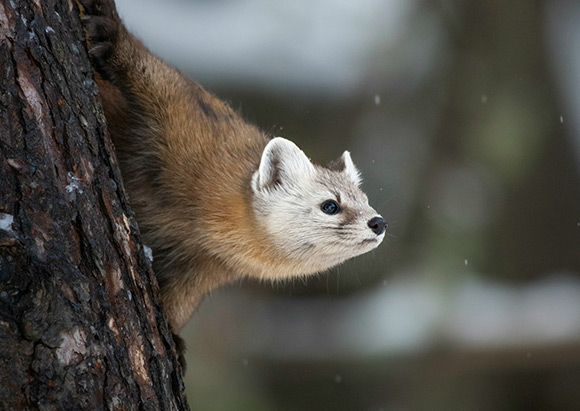
A Marten that doesn't currently need CPR. Photo: Jeremy Hynes/Unsplash
According to a Minneapolis Star-Tribune report, a northern Minnesota trapper who inadvertently caught an out-of-season marten in one of his Beltrami County bobcat snares gave the marten CPR to revive the animal then set it free. According to the news article by Paul Walsh, the trapper was checking his bobcat snares when discovered the marten. Knowing it was not permissible to keep the nearly dead animal, he called Conservation Officer Nick Prachar, asking what he might do about the situation. Prachar told the newspaper the trapper quickly hung up, then called him back to say the marten would make it after all. Why? The trapper told Prachar he started blowing on the marten’s nose and massaging its chest – essentially performing CPR on the marten. “Next thing you know,” Prachar told Walsh, “it started moving, moving its eyes and came back to life.” “When he first told me he did CPR,” Prachar told Walsh, “I asked him, ‘You mean it didn’t eat your face off?’” Prachar described martens as “vicious and mean as heck.” The trapper, still unsure the marten would make it, drove the marten to his home and met Prachar there. Prachar said the marten looked pretty healthy and was “chirping and yelling” when Prachar scooped it out of the trapper’s side-by-side off-road vehicle with a leaf rake. Then it ran off into the woods. Minnesota trappers can catch only two total martens or fishers, or one of each during the state’s nine day combined December season. Prachar said he’s seen lots of odd wildlife rescue situations, but this was the first that involved CPR on a wild animal. (Thanks to Patrick Lanin, of Minnesota, for sharing this story with FUR-FISH-GAME.)
Nebraska Teen Bags Trophy Bighorn
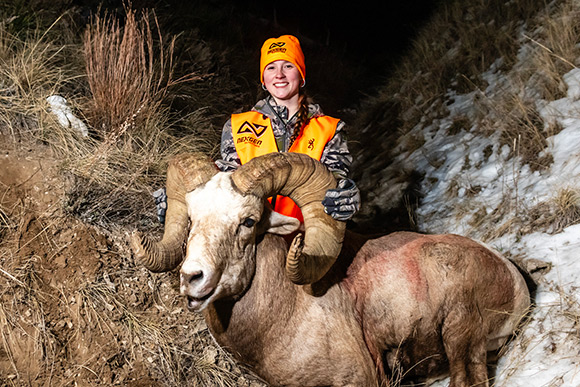
Kiersten Black, of Sidney, Nebraska with her world-class trophy-caliber bighorn ram. Photo: NGPC
Kiersten Black, of Sidney, wasn’t the only Nebraska teenager to hunt big game during autumn, but the bighorn sheep she tagged was her first, a world-class trophy-caliber ram. On Saturday, December 2, on private land in the Pine Ridge escarpments southwest of Chadron, Black, 15, shot the ram. She was one of two winners of a bighorn hunting permit drawn from a pool of more than 3,500 applicants in Nebraska’s bighorn lottery. The tag cost all of $29, an application fee. Black hunted with her father Trevor Black, younger brother Reed and family friend Tate Pieper. They caught sight of the big ram with a group of ewes first thing that morning, but the sheep slipped into the trees and wasn’t spotted again until seven hours of searching the steep canyons later. With her father’s coaching, Kiersten made a successful stalk and shot at sundown with just 25 minutes of legal shooting light to spare. Todd Nordeen, the Nebraska Game and Parks Commission biologist who oversees the state’s bighorn program, said the ram was 10-1/2-years old, in the final stages of a 9- to 12-year average lifespan. Kiersten has developed an impressive hunting resume: The first of the five deer she has harvested was a whitetail buck with 150-class antlers, and she tagged a big mule deer buck in Colorado in 2023. The teen said the bighorn sheep hunt was a thrilling experience, including the moment she learned her name was drawn. Kiersten is a sophomore at Sidney High School. As a convenient coincidence, her Sidney Red Raider basketball team played at Chadron on the eve of the hunt. Had it been any other location, she’d have sacrificed basketball for the once-in-a-lifetime hunt. The other hunter won his permit by auction and shot an impressive ram in the Wildcat Hills of Banner County. These sheep mark the 33rd and 34th harvested in Nebraska since Game and Parks’ bighorn hunting program began in 1998. Kiersten is just the second female and second teenager to harvest one in the state. Nebraska’s reintroduced bighorn sheep in the 1980s, to remedy the unregulated hunting, habitat loss and disease that led to their extirpation during in the late 1800s. Nebraska’s bighorn population tops 250 rams, ewes and lambs in both the Wildcat Hills and Pine Ridge.
Iowa Gray Fox Research Project
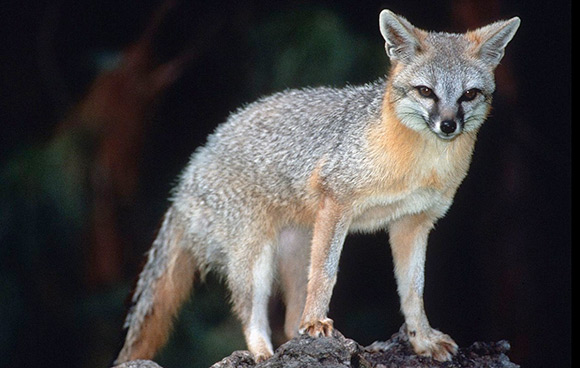
A gray fox. Photo: CA Dept. of Water Resources
The Iowa Department of Natural Resources (IDNR) is asking trappers for help with a study on Iowa’s gray fox population, and there’s a $400 reward involved. IDNR Wildlife Technician Dave Hoffman is asking trappers who catch a gray fox alive to contact him, another wildlife technician, a local wildlife biologist or conservation officer directly so they can arrange to equip the animal with a neck collar and release it to track the fox as part of a research project. IDNR is offering a $400 reward for live-caught foxes that are healthy and can be used for the study. Hoffman says Iowa’s gray fox population is down and IDNR is concerned. Gray fox numbers in Iowa and across the Midwest have declined during the last 25 years. In Iowa, the decline is correlated with increased number of coyotes, raccoons and bobcats. Coyotes and bobcats may reduce gray fox numbers through competition and predation. Raccoons can spread disease, particularly canine distemper, which hits gray foxes hard. Forest habitat changes may also be involved. Mature, even-aged forests don’t support gray fox prey. A combination of these factors, as well as other potential unknown factors, may contribute to the decline. IDNR is hoping the study will provide some answers on mortality, habitat use, home ranges, and other information. To get in touch with Hoffman, call (641) 425-0737, or Vince Evelsizer (641) 231-1522. (Thanks to Jesse Downs, of Readstown, Wisconsin for sharing this.)
41% of Deer Hunters Harvest Deer
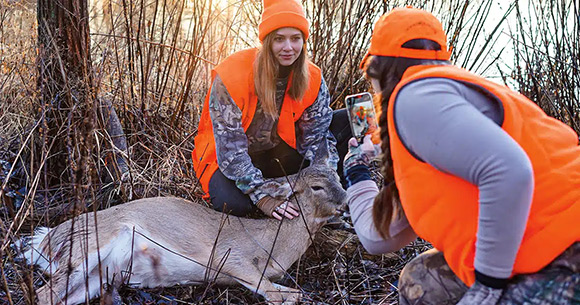
Two female hunters celebrate their whitetail success. Photo: NDA
According to a report by the National Deer Association (NDA), an average of 41% of all deer hunters successfully harvested at least one deer during the 2022-23 hunting season, and 17% took two or more. NDA’s latest Deer Report says these success rates varied widely by state and region. “Multiple deer bag limits are the norm today, and some hunters perceive this as assuring an overharvest of deer,” said NDA Chief Conservation Officer Kip Adams and one of the report’s authors. “However, the reality is only a small percentage of hunters actually fill multiple tags. For example, a license in Georgia allows two bucks and 10 antlerless deer, but nearly half of Georgia’s hunters do not harvest a single whitetail.” Regionally, the Southeast led the country with 56% of hunters successfully taking at least one deer. The Midwest was next, with 40% of its hunters taking a deer, followed by the West (35%) and Northeast (33%). The Southeast also led the country with 26% of hunters shooting two or more deer, followed by the Midwest (14%) and Northeast (11%). NDA’s latest analysis also reveals the percentage of successful hunters is down from 48% in 2011, marking a 7% decline. Likewise, the national average for hunters harvesting two or more deer decreased from 21% to 17% during that same period. Overall, hunter success rates have decreased in all U.S. regions, with the Northeast experiencing the largest decline. For the full report visit deerassociation.com/2024-deer-report/
Missouri Deer Harvest Sets Record
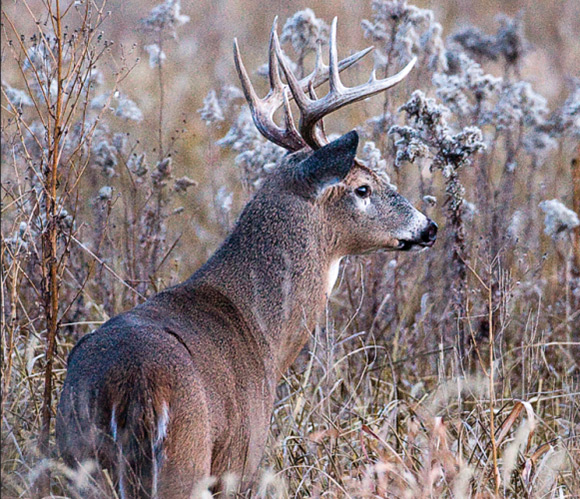
Whitetail buck. Photo: MDC
Missouri's 2023-2024 deer-hunting season ended Jan. 15 with the Missouri Department of Conservation (MDC) reporting a preliminary record-setting total deer harvest of 326,026. This surpasses 2006’s record of 325,457. Of the deer harvested, 147,705 were antlered bucks, 29,060 were button bucks, and 149,261 were does. Top harvest counties for the overall deer season were Franklin with 7,395, Howell with 6,346, and Texas with 6,181. Hunters harvested 299,719 deer during the 2022-2023 deer hunting season with 140,735 being antlered bucks, 27,028 being button bucks, and 131,956 being does. MDC says increasing deer numbers and regulation changes that added a new early antlerless firearms season, a new chronic wasting disease (CWD) firearms season, and an increase in the number of firearms antlerless deer hunting permits in most counties contributed to the record harvest. Also, this year was the first since 2013 that more does were harvested than antlered bucks. This year’s antlered buck harvest is also the highest on record, MDC says.
Backyard Feeding: More Harm Than Good
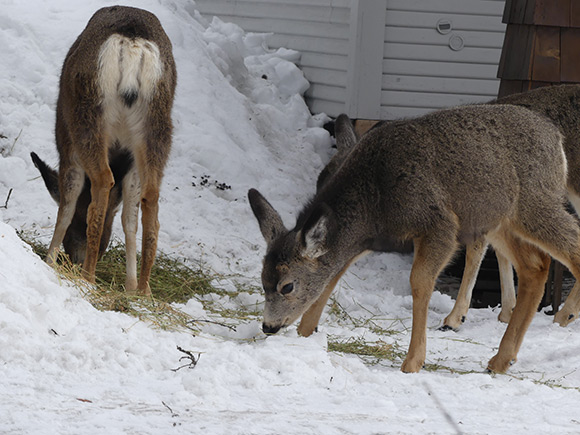
Mule deer feeding in a backyard. Photo: IDGF
It may seem like helping, but handouts for wintering deer and elk ultimately harm the animals and people, says Idaho’s Game and Fish Department. Wild animals need to remain wild animals and feeding can quickly create a variety of problems. Feeding wildlife can do more harm than good: Large quantities of wildlife in small areas can increase the chances of spreading diseases. Deer and elk digestive systems have adapted to different types of forage for different times of the year. During winter, it’s dried, low-nutrient forage. Adding unnatural, rich food to their diet can create serious digestive problems, bloat and even death. Feeding deer and elk in neighborhoods can also attract them to deadly plants commonly used in landscaping. In January of 2022, in the Wood River valley, despite Blaine County’s ordinance restricting the planting of poisonous plants, five elk were found dead in residential areas after they consumed toxic yew plants. Two of those elk were calves. In 2015-16, the same noxious yew plant killed at least 20 elk in the same area. As more deer and elk congregate in towns, the chances of vehicle collisions increase. Feeding a few deer can very quickly lead to many more looking for handouts, concentrating unnaturally high numbers in small areas. In very rare cases – emergency situations – IDGF managers may supplement deer or elk forage with winter feed, or to prevent conflicts between big game and agricultural operations, as well as a means of luring big game herds away from congested freeways or on ramps. Extreme winters can sometimes cause winter forage to become limited or unavailable, sometimes for prolonged periods of time. However, these instances are uncommon. If you want to help wintering wildlife, rather than feeding, observe them from a distance and appreciate that you live in a place that provides deer and elk with suitable habitat.
See Any Pennsylvania Turkeys?
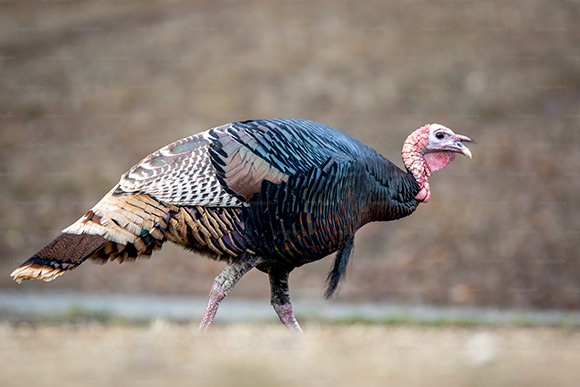
A wild turkey gobbler. Photo: Matt Bango/Unsplash
The Pennsylvania Game Commission (PGC) is asking for the public’s help finding turkey flocks to trap for ongoing turkey projects. Pennsylvanians are encouraged to report the location of any turkey flocks they see online at https://pgcdatacollection.pa.gov/TurkeyBroodSurvey through March 15. Visitors to that webpage will be asked to provide the date of the sighting, the location, and the type of land (public, private or unknown) where birds are seen, among other things. Game Commission crews will visit these sites to assess them for the potential to trap turkeys. Turkeys will not be moved. They’ll be leg banded and released on site. Some 250 birds, in certain Wildlife Management Units, will also be fitted with GPS transmitters, then be released to be monitored over time. Trapping turkeys is part of PGC's ongoing population monitoring, and provides information for a large-scale turkey study, as well. The information collected gives PGC data on survival rates and spring harvest rates. The studies are being done in partnership with Penn State University and the University of Pennsylvania’s Wildlife Futures Program.
Endangered Aquatic Species Gets Second Chance
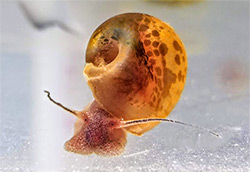
A magnificent ramshorn snail. Photo: NCWRC
After 20 years of living only in captivity, the federally endangered magnificent ramshorn snail has been returned to the wild. The North Carolina Wildlife Resources Commission (NCWRC) reintroduced 2,000 of these aquatic snails into a pond on NCWRC Game Lands in Brunswick County. The magnificent ramshorn is a large freshwater snail, found only the lower Cape Fear River basin in North Carolina. The snail is about 1.5 inches long when fully grown, with leopard-like spots on its shell and a rich, maroon-colored body. The snails were captive bred at NCWRC’s Conservation Aquaculture Center in Marion, then transported across the state to the release site in a collaborative project with the U.S. Fish and Wildlife Service, the Coastal Plain Conservation Group, North Carolina State University and the Military Ocean Terminal at Sunny Point. Original wild populations died out from degradation of natural habitats and poor water quality, according to NCWRC’s Inland Fisheries Chief Christian Waters. In early October of 2023, a small batch of reintroduced snails was placed in the pond to document how the animals would respond in the wild. Monitoring confirmed the stocking was a success. NRWRC then moved forward with a mid-November stocking of additional snails. “We are excited about the promising early results, representing a significant step toward species recovery,” said Emilia Omerberg, NCWRC Aquatic Snail Biologist. “Initial monitoring indicates the snails have survived and reproduced in the pond, including the first wild hatches since the early 2000s.” NCWRC biologists will monitor the snails’ progress and may add more to the pond later. They’re also researching potential future locations for stocking as well.
Reduce Salt Use This Winter
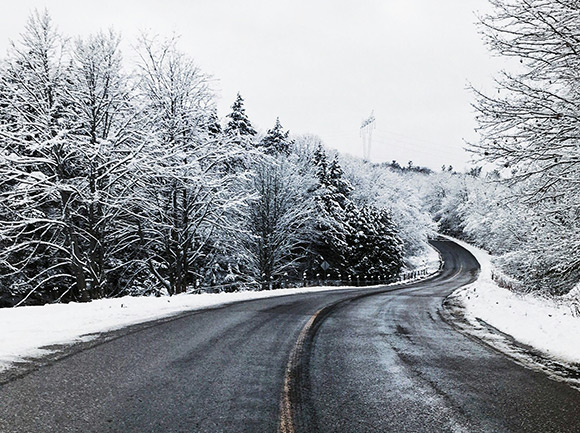
Wisconsin is urging residents to reduce salt use this winter. Photo: Francesca Saraco/Unsplash
The Wisconsin Department of Natural Resources (WDNR) and Wisconsin Salt Wise is urging residents to reduce salt use this winter. Although salt keeps Wisconsin roads safe during winter, using more salt than needed comes at a price. In Wisconsin and much of the U.S., chlorides from salt are infiltrating lakes, streams and groundwater. According to Wisconsin Salt Wise, one teaspoon of salt is all it takes to make five gallons of water toxic for freshwater organisms. WDNR measures chloride levels in 26 of the state’s largest rivers over time. Recent studies show a steep increase in chloride loads: In the early 2000s, the DNR measured about 600,000 tons of chlorides annually. By 2018, that increased to nearly 800,000 tons per year. Some 50 lakes and one stream have been impaired by high salt concentrations. Some of the increased chloride loads are due to road salting, but chlorides also enter state waters via water softeners and fertilizers.
To reduce salt use, WDNR offers these tips:
• Shovel walkways and other areas before snow turns to ice. The more snow removed manually, the less salt is needed and the more effective it is.
• Scatter salt it so there’s space between the grains. A 12-ounce coffee mug of salt is enough to treat an entire 20-foot driveway or 10 sidewalk squares.
• Salt doesn’t work when pavement temperatures drop below 15 degrees. Switch to sand for traction or a different ice melter that works at lower temperatures.
WDNR is working to reduce chlorides at the source through permitting programs for municipalities and industries, tuning or replacing water softeners, identifying significant chloride contributors and finding reductions, process efficiencies or improvements by instituting sewer use ordinances. Also, WDOT is working with counties to reduce road salt application using brine and pre-wetting road surfaces, significantly reducing salt use. For more information visit dnr.wisconsin.gov/topic/Stormwater/learn_more/salt.html
CWD Detected Near Deer Lodge
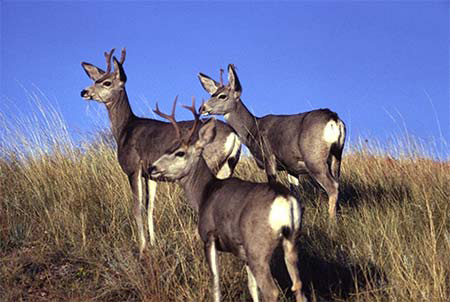
A trio of mule deer. Photo: Alaska Game and Fish Department
Chronic wasting disease (CWD) was recently detected in a mule deer buck harvested by a hunter in Montana’s hunting district (HD) 213, west of Deer Lodge. This is the first CWD case detected in HD 213 also in Fish, Wildlife & Parks’ Region 2. CWD is a contagious neurological disease that can infect deer, elk and moose. It’s always fatal, and there is no known cure. It was first detected in Montana’s wild herds in 2017. The disease is known to exist in various regions of Montana, the closest about 100 miles southeast of HD 213. Surveillance will continue in 2024 to understand more about CWD’s prevalence in this area and other parts of the state. CWD is not known to infect humans. However, the Centers for Disease Control and Prevention (CDC) recommends that people not eat meat from infected animals and have their harvested animals tested before eating them if they were taken from an area where CWD is known to exist.
Upcoming Events
Central Maine Spring Fur Auction
The Central Maine Chapter of the Maine Trappers’ Association is holding its annual Spring Fur Auction on April 21, at the Palmyra Community Center, located at 768 Main St., Palmyra, Maine. Doors open at 7 a.m. For more info contact Ted Perkins at (207) 570-6243 or check mainetrappers.com for updates.
Idaho Trappers Fur Sales, Banquet
The Idaho Trappers Association will hold a fur sale March 8 -10 at the Elmore County Fairgrounds, in Glenns Ferry, Idaho. The event features trapping demos, the live auction, trap and lure vendors and other items. On Saturday, April 6, ITA, Furbearers Unlimted and NTF will host an annual banquet at the Twin Falls County Fairgrounds, 215 Fair Ave, in Filer Idaho. For more information, contact Mike Murdock at (208) 716-0377, email: mikemurdock95@gmail.com, Rusty Kramer at (208) 870-3217, or visit www.idahotrappersassociation.com
What’s Coming in March
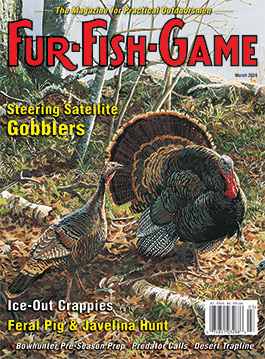
Steering Satellite Gobblers Your Way - Bruce Ingram says focus on calling in the satellite gobblers, not the boss tom, for spring turkey success.
Ice Out Crappies - Phil Goes shares a humorous and how-to look at catching crappies when winter’s ice leaves local waterways.
Texas Two-Step - Joe Blake tells how an archery hunt journey to South Texas resulted in both a feral pig and a javelina.
A Turkey Hunter’s Tale - William Moon’s encounter with an older hunter leads to a new understanding of public land spring gobbler hunting, and the older generation.
A More Respectable Bird - Brady J. Crytzer offers an historical look at America’s love affair with wild turkeys.
Other stories in this issue include:
• Maintaining River Otter Sustainability – Biologist Lucas Byker shares his thoughts on how trappers can maintain otter populations along their favorite waterways for sustainable catches each trapping season.
• High Desert Trapline - Brett Bonecutter relates the trial and tribulations he experienced running a high desert trapline in Utah.
• Lew & Charlie, Chapter VI, Part I – The Big Snow, Part 1
• Fishing: Bringing Generations Together – David R. Thompson shares thoughts on introducing youngsters to fishing.
• Think Like A Mink - Andrew Zysek says to catch more mink trappers must think like a mink.
• What Bowhunters Should Do Now for Fall - Ryan Fair offers a number of tips that bowhunters can be doing this spring to make their fall hunting more successful.
• Two Hunters Share a Tree – Teresa Gail Hill tells how her father shared a cedar tree with a bobcat during an intense Texas rainstorm.
• Cheap Scope, High Dollar Cat – Landon Wardell shares how despite a cheap scope on his .22 magnum, he tagged a high-dollar bobcat near his ranch.
• A Tough Winter for Beaver Trapping – Austin Anderson’s story about the difficulties he encountered during British Columbia’s beaver season will resonate with other trappers.
• Skunked! – W.D. Baker’s entry into trapping didn’t quite turn out the way he thought it might, resulting in a funny tale any trapper can relate to.
End of the Line Photo of the Month
Kelly Rozzi & Pearl, Fowler, Ohio
SUBSCRIBE TO FUR-FISH-GAME Magazine

